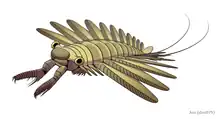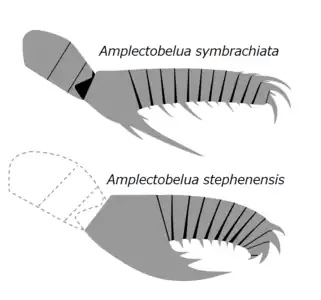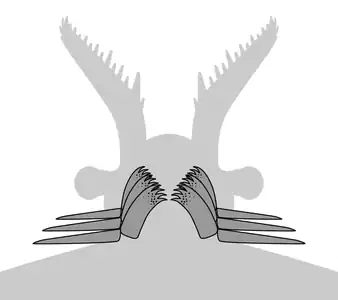| Amplectobelua Temporal range: Cambrian Stage 3, | |
|---|---|
 | |
| Reconstruction of Amplectobelua symbrachiata | |
 | |
| Fossil specimen, showing frontal appendages, head carapace, gnathobase-like structures and body flaps | |
| Scientific classification | |
| Domain: | Eukaryota |
| Kingdom: | Animalia |
| Phylum: | Arthropoda |
| Class: | †Dinocaridida |
| Order: | †Radiodonta |
| Clade: | †Amplectobeluidae |
| Genus: | †Amplectobelua Hou, Bergström & Ahlberg, 1995 |
| Species | |
| |
Amplectobelua (meaning "embracing beast") is an extinct genus of late Early Cambrian amplectobeluid radiodont, a group of stem arthropods that mostly lived as free-swimming predators during the first half of the Paleozoic Era.
Anatomy

Amplectobelua was a giant radiodont, A. symbrachiata had body length (without frontal appendages and tail) reaching up to 90 cm (3.0 ft).[2][3] The body structures other than frontal appendages are only known from the type species Amplectobelua symbrachiata. Like other radiodonts, Amplectobelua had a pair of jointed frontal appendages, a head covered by dorsal and lateral sclerites (the latter had been misinterpreted as huge eyes[4]), a limbless body with dorsal gills (setal blades), and a series of flaps on both sides that extended along the length of its body.
Amplectobelua had a specialized frontal appendage, in which it has a distinct 3-segmented shaft region and 12-segmented distal articulated region, and the spine on the fourth segment (first segment of distal articulated region) hooked forward to oppose the tip of the appendage, allowing it to grasp prey like a pincer. Amplectobelua had 11 pairs of body flaps in total, they are relatively elongated and straight in outline. The size of the flaps decrease posteriory, and each of their frontal margin have rows of vein-like structures (strengthening rays). The neck region have at least 3 pairs of slender, reduced anterior flaps.[4] The trunk terminated with a pair of long furcae (streamers).
 Frontal appendages of A. symbrachiata and A. stephenensis. Note the shaft region of A. stephenensis is unknown.
Frontal appendages of A. symbrachiata and A. stephenensis. Note the shaft region of A. stephenensis is unknown. Ventral view of a generalized GLS-bearing radiodont, showing 3 pairs of gnathobase‐like structures (GLSs) and corresponded anterior flaps.
Ventral view of a generalized GLS-bearing radiodont, showing 3 pairs of gnathobase‐like structures (GLSs) and corresponded anterior flaps.
Amplectobelua shares a unique feature among radiodonts with Ramskoeldia, in having gnathobase-like structures (GLSs) underneath its neck region, at least 6, up to eight. They functioned like the gnathobases of arthropods, being able to rotate and move to shred prey. They were connected to reduced anterior flaps. Additionally, the mouth (oral cone) of Amplectobelua were interpreted as different from typical radiodont, lacking the typical Peytoia-style oral cone and possessing numerous flat tooth-plates with unclear, but possibly non-radial arrangement.[4]
Species
Two species are known, Amplectobelua symbrachiata from the Chengjiang biota and Amplectobelua stephenensis from the later Burgess Shale.[5] A. symbrachiata is known from complete specimens, while A. stephenensis is known only from isolated frontal appendages. A. stephenensis is more advanced, with the frontal appendages being more specialized for grasping: the fourth spine is larger and the spines on outer segments are reduced.
Ecology

Amplectobelua was likely nektonic predator.[2] Its frontal appendages were worked like pincers to pinch prey. Its structure was suitable to firmly grasp and manipulate prey to the mouth or tearing off pieces from larges carcasses.[6] Gnathobase-like structures were probably used to chew preys.[4] Research of 432 specimens resulted that it would be an extremely fast-growing animal for an arthropod.[3]
See also
References
- ↑ Yang, C.; Li, X.-H.; Zhu, M.; Condon, D. J.; Chen, J. (2018). "Geochronological constraint on the Cambrian Chengjiang biota, South China" (PDF). Journal of the Geological Society. 175 (4): 659–666. Bibcode:2018JGSoc.175..659Y. doi:10.1144/jgs2017-103. ISSN 0016-7649. S2CID 135091168.
- 1 2 Lerosey-Aubril R, Pates S (September 2018). "New suspension-feeding radiodont suggests evolution of microplanktivory in Cambrian macronekton". Nature Communications. 9 (1): 3774. Bibcode:2018NatCo...9.3774L. doi:10.1038/s41467-018-06229-7. PMC 6138677. PMID 30218075.
- 1 2 Wu, Yu; Pates, Stephen; Pauly, Daniel; Zhang, Xingliang; Fu, Dongjing (2023-11-03). "Rapid growth in a large Cambrian apex predator". National Science Review. doi:10.1093/nsr/nwad284. ISSN 2095-5138.
- 1 2 3 4 Cong, Peiyun; Daley, A. C.; Edgecombe, Gregory D.; Hou, Xianguang (2017). "The functional head of the Cambrian radiodontan (stem-group Euarthropoda) Amplectobelua symbrachiata". BMC Evolutionary Biology. 17 (208): 208. doi:10.1186/s12862-017-1049-1. PMC 5577670. PMID 28854872.
- ↑ Daley, A. C.; Budd, G. E. (2010). "New anomalocaridid appendages from the Burgess Shale, Canada". Palaeontology. 53 (4): 721. Bibcode:2010Palgy..53..721D. doi:10.1111/j.1475-4983.2010.00955.x.
- ↑ De Vivo, Giacinto; Lautenschlager, Stephan; Vinther, Jakob (2021-07-28). "Three-dimensional modelling, disparity and ecology of the first Cambrian apex predators". Proceedings of the Royal Society B: Biological Sciences. 288 (1955): 20211176. doi:10.1098/rspb.2021.1176. ISSN 0962-8452. PMC 8292756. PMID 34284622.
External links
- "Amplectobelua stephenensis". Burgess Shale Fossil Gallery. Virtual Museum of Canada. 2011. Archived from the original on 2020-11-12. Retrieved 2023-01-21.
- Anomalocaris Homepage
